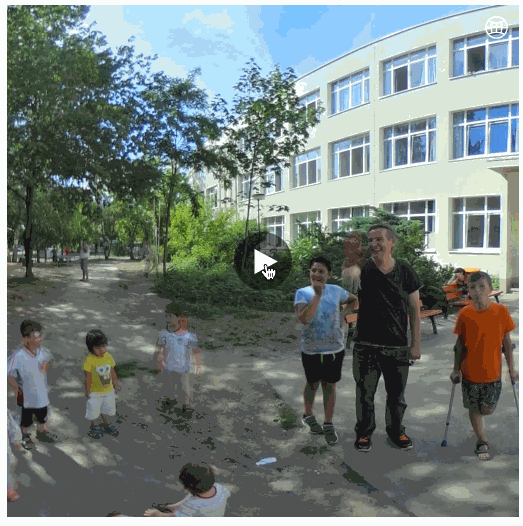WordPress Now Supports Embedded Virtual Reality Media
Powering over 26% of the web from personal blogs to major sites like CNN and Best Buy, WordPress is the world’s most popular online publishing platform, and now it has made it possible to publish and view virtual reality content on any WordPress.com site. Although sharing and viewing VR content has been available through additional simple plug-ins such as VR Views and WP-VR-view for a while now, this announcement marks the first official implementation of VR content on the WordPress platform. Considering the blogs that WordPress hosts collectively receive 15.5 billion page views each month, by 409 million people, this is a milestone in terms of expansion for VR content.
 “Our goal is to make publishing VR content as simple as publishing text or photos to the web — just add VR content to your site and anyone with a web browser can instantly enjoy it,” explained Toni Schneider, Team Lead at Automattic, in a blog post. He also added: “It will be in Jetpack soon, as soon as the next Jetpack release comes out,” Schneider said. “The technology is built to work on all WordPress sites and even beyond that, on any website. We consider this first release just a start. As soon as we see how people use it, we will start adding more features and supporting more types of VR experiences.”
“Our goal is to make publishing VR content as simple as publishing text or photos to the web — just add VR content to your site and anyone with a web browser can instantly enjoy it,” explained Toni Schneider, Team Lead at Automattic, in a blog post. He also added: “It will be in Jetpack soon, as soon as the next Jetpack release comes out,” Schneider said. “The technology is built to work on all WordPress sites and even beyond that, on any website. We consider this first release just a start. As soon as we see how people use it, we will start adding more features and supporting more types of VR experiences.”
The 360-photo feature has been made available to all blog account types, however, the 360-video uploader is still in beta and will launch only for premium or business WordPress.com accounts.
Readers will be able to view and interact with the content in their browsers on a desktop. However, they are best viewed from a smartphone browser, when your smartphone is placed inside a compatible headset. Google Cardboard, Samsung Galaxy Gear, Google Daydream, Oculus Rift and the HTC Vive are the ones pointed to by WordPress. Alternatively, you can download experimental browser builds to view 360 content inside a desktop VR headset like the Rift or Vive. In other words, the viewing experience varies depending on what device you are utilizing to display the site. On the desktop, with a 360-degree video player embedded, users can click and drag to change the perspective in 2D just like the 360-degree YouTube and Facebook player or Google Street View app. On mobile, though, you need to move your device around to change the perspective. There is a small button which, when clicked, broadcasts the content straight into the VR goggles.
Users can then add 360° photos and videos to posts using a “vr” shortcode: [vr url=path-to-photo.jpg view=360] or [vr url=path-to-photo.jpg view=cinema]. Here is an example by The Harvard Gazette’s story entitled Confronting the Refugee Crisis to see the new VR content in action as it is optimized for VR viewing on Wordpress sites:

Will VR Technology Really Stick?
Mario García, Media Consultant and Adjunct Professor at Columbia University Graduate School of Journalism, predicted in the article entitled NiemanLab’s Predictions for Journalism 2017: “One form of storytelling that will gain momentum: virtual reality,” and García added: “It’s no coincidence: Editors and publishers are looking for ways to tell stories on mobile devices, and the future of virtual reality is also on mobile. For many newsrooms, VR is going to be the one big area for experimentation in 2017.” Garcia is not the only one who comes up with this prediction, though. As I cited in one of my most recent articles entitled 6 Enterprise Tech Trend Predictions for 2017 and Beyond, worldwide revenues for the augmented reality and virtual reality (AR/VR) market will grow from $5.2 billion in 2016 to more than $162 billion in 2020, according to the new Worldwide Semiannual Augmented and Virtual Reality Spending Guide from the International Data Corporation (IDC). Gartner also suggests enterprises look for targeted applications of VR and AR through 2020.
Apple was awarded new patents for a wireless VR headset last fall and it is expected to come to fruition in 2017. In fact, there has been a rumor flying around that Apple is planning to launch a new iPhone with a "clear glass", which you can hold up to your face and see AR/VR through the OLED screen this coming year.
2017. In fact, there has been a rumor flying around that Apple is planning to launch a new iPhone with a "clear glass", which you can hold up to your face and see AR/VR through the OLED screen this coming year.
Despite the fact that there are plenty of VR skeptics, there are also many investors and innovators who have been putting a lot of money and energy into the expansion of this technology. Marxent, for instance, is a provider of virtual reality (VR) and augmented reality (AR) for retailers and manufacturers, and the Dayton, Ohio- based startup aims to make the content management system for companies’ new virtual and augmented reality applications. Last April, the company closed $10 million in Series B funding which brought the total invested in Marxent to $14 million. The funding has been used by Marxent with capital, to leverage its VisualCommerce product that is designed to help businesses that have wide product catalogs, use virtual and/or augmented reality to sell what they have. With an exclusive focus on dynamic 3D content management and turn-key AR/VR app templates, the company has built its partnerships with Fortune 500 retailers and manufacturers. As a result, the platform has been positioned as one of the leading enterprise-ready solutions in the marketplace.
 “We’re not creating new demand. Retailers and manufacturers have been investing in visualization, visual merchandising and customer experience since the beginning of time,” said Beck Besecker, Marxent’s Co-founder and CEO. “High-quality product visualization and remarkable customer experiences have always been a core tenet of retail and direct sales models. We saw an opportunity to enhance, and in some cases, replace, classic visual merchandising tactics such as photography, paint samples, store windows and catalogs with an exciting 3D high-tech experience that is waste-free, portable, device agnostic and has a limited footprint.”
“We’re not creating new demand. Retailers and manufacturers have been investing in visualization, visual merchandising and customer experience since the beginning of time,” said Beck Besecker, Marxent’s Co-founder and CEO. “High-quality product visualization and remarkable customer experiences have always been a core tenet of retail and direct sales models. We saw an opportunity to enhance, and in some cases, replace, classic visual merchandising tactics such as photography, paint samples, store windows and catalogs with an exciting 3D high-tech experience that is waste-free, portable, device agnostic and has a limited footprint.”
Although the consumption for virtual reality hasn’t been streamlined yet, mostly due to the lack of access to headsets - a few million headsets at the last count, it is definitely considered as one of the top technologies that enterprises are eyeing on. Enabling VR to be a natively supported part of WordPress-powered publications, will definitely help many content creators publish VR content like a breeze in 2017. It would be ambitious to say that by next year around this time, we’ll be experiencing all of the web through VR, which is called WebVR. However, it is safe to say that many more businesses will incorporate their storytelling repertoire with the augmented reality and virtual reality technology to create more VR-centric websites this coming year. As a result of the rising demand, we will also see many content management vendors, enhance their platforms with an exclusive focus on the VR/AR capabilities in 2017.

Venus Tamturk
Venus is the Media Reporter for CMS-Connected, with one of her tasks to write thorough articles by creating the most up-to-date and engaging content using B2B digital marketing. She enjoys increasing brand equity and conversion through the strategic use of social media channels and integrated media marketing plans.